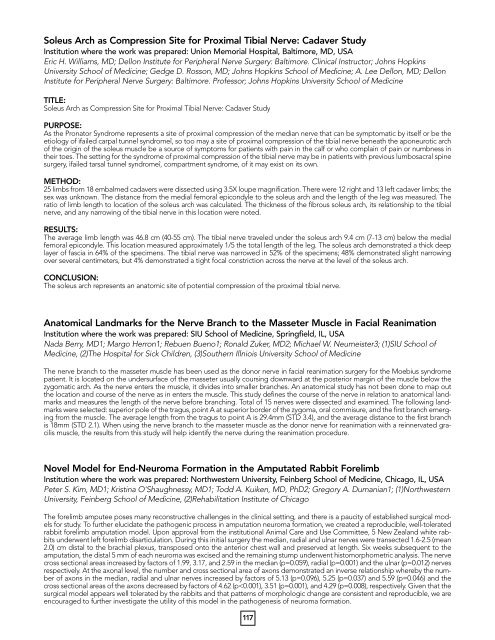Floor plan - 2013 Annual Meeting - American Association for Hand ...
Floor plan - 2013 Annual Meeting - American Association for Hand ...
Floor plan - 2013 Annual Meeting - American Association for Hand ...
Create successful ePaper yourself
Turn your PDF publications into a flip-book with our unique Google optimized e-Paper software.
Soleus Arch as Compression Site <strong>for</strong> Proximal Tibial Nerve: Cadaver Study<br />
Institution where the work was prepared: Union Memorial Hospital, Baltimore, MD, USA<br />
Eric H. Williams, MD; Dellon Institute <strong>for</strong> Peripheral Nerve Surgery: Baltimore. Clinical Instructor; Johns Hopkins<br />
University School of Medicine; Gedge D. Rosson, MD; Johns Hopkins School of Medicine; A. Lee Dellon, MD; Dellon<br />
Institute <strong>for</strong> Peripheral Nerve Surgery: Baltimore. Professor; Johns Hopkins University School of Medicine<br />
TITLE:<br />
Soleus Arch as Compression Site <strong>for</strong> Proximal Tibial Nerve: Cadaver Study<br />
PURPOSE:<br />
As the Pronator Syndrome represents a site of proximal compression of the median nerve that can be symptomatic by itself or be the<br />
etiology of ìfailed carpal tunnel syndromeî, so too may a site of proximal compression of the tibial nerve beneath the aponeurotic arch<br />
of the origin of the soleus muscle be a source of symptoms <strong>for</strong> patients with pain in the calf or who complain of pain or numbness in<br />
their toes. The setting <strong>for</strong> the syndrome of proximal compression of the tibial nerve may be in patients with previous lumbosacral spine<br />
surgery, ìfailed tarsal tunnel syndromeî, compartment syndrome, of it may exist on its own.<br />
METHOD:<br />
25 limbs from 18 embalmed cadavers were dissected using 3.5X loupe magnification. There were 12 right and 13 left cadaver limbs; the<br />
sex was unknown. The distance from the medial femoral epicondyle to the soleus arch and the length of the leg was measured. The<br />
ratio of limb length to location of the soleus arch was calculated. The thickness of the fibrous soleus arch, its relationship to the tibial<br />
nerve, and any narrowing of the tibial nerve in this location were noted.<br />
RESULTS:<br />
The average limb length was 46.8 cm (40-55 cm). The tibial nerve traveled under the soleus arch 9.4 cm (7-13 cm) below the medial<br />
femoral epicondyle. This location measured approximately 1/5 the total length of the leg. The soleus arch demonstrated a thick deep<br />
layer of fascia in 64% of the specimens. The tibial nerve was narrowed in 52% of the specimens; 48% demonstrated slight narrowing<br />
over several centimeters, but 4% demonstrated a tight focal constriction across the nerve at the level of the soleus arch.<br />
CONCLUSION:<br />
The soleus arch represents an anatomic site of potential compression of the proximal tibial nerve.<br />
Anatomical Landmarks <strong>for</strong> the Nerve Branch to the Masseter Muscle in Facial Reanimation<br />
Institution where the work was prepared: SIU School of Medicine, Springfield, IL, USA<br />
Nada Berry, MD1; Margo Herron1; Rebuen Bueno1; Ronald Zuker, MD2; Michael W. Neumeister3; (1)SIU School of<br />
Medicine, (2)The Hospital <strong>for</strong> Sick Children, (3)Southern Illniois University School of Medicine<br />
The nerve branch to the masseter muscle has been used as the donor nerve in facial reanimation surgery <strong>for</strong> the Moebius syndrome<br />
patient. It is located on the undersurface of the masseter usually coursing downward at the posterior margin of the muscle below the<br />
zygomatic arch. As the nerve enters the muscle, it divides into smaller branches. An anatomical study has not been done to map out<br />
the location and course of the nerve as in enters the muscle. This study defines the course of the nerve in relation to anatomical landmarks<br />
and measures the length of the nerve be<strong>for</strong>e branching. Total of 15 nerves were dissected and examined. The following landmarks<br />
were selected: superior pole of the tragus, point A at superior border of the zygoma, oral commisure, and the first branch emerging<br />
from the muscle. The average length from the tragus to point A is 29.4mm (STD 3.4), and the average distance to the first branch<br />
is 18mm (STD 2.1). When using the nerve branch to the masseter muscle as the donor nerve <strong>for</strong> reanimation with a reinnervated gracilis<br />
muscle, the results from this study will help identify the nerve during the reanimation procedure.<br />
Novel Model <strong>for</strong> End-Neuroma Formation in the Amputated Rabbit Forelimb<br />
Institution where the work was prepared: Northwestern University, Feinberg School of Medicine, Chicago, IL, USA<br />
Peter S. Kim, MD1; Kristina O'Shaughnessy, MD1; Todd A. Kuiken, MD, PhD2; Gregory A. Dumanian1; (1)Northwestern<br />
University, Feinberg School of Medicine, (2)Rehabilitation Institute of Chicago<br />
The <strong>for</strong>elimb amputee poses many reconstructive challenges in the clinical setting, and there is a paucity of established surgical models<br />
<strong>for</strong> study. To further elucidate the pathogenic process in amputation neuroma <strong>for</strong>mation, we created a reproducible, well-tolerated<br />
rabbit <strong>for</strong>elimb amputation model. Upon approval from the institutional Animal Care and Use Committee, 5 New Zealand white rabbits<br />
underwent left <strong>for</strong>elimb disarticulation. During this initial surgery the median, radial and ulnar nerves were transected 1.6-2.5 (mean<br />
2.0) cm distal to the brachial plexus, transposed onto the anterior chest wall and preserved at length. Six weeks subsequent to the<br />
amputation, the distal 5 mm of each neuroma was excised and the remaining stump underwent histomorphometric analysis. The nerve<br />
cross sectional areas increased by factors of 1.99, 3.17, and 2.59 in the median (p=0.059), radial (p=0.001) and the ulnar (p=0.012) nerves<br />
respectively. At the axonal level, the number and cross sectional area of axons demonstrated an inverse relationship whereby the number<br />
of axons in the median, radial and ulnar nerves increased by factors of 5.13 (p=0.096), 5.25 (p=0.037) and 5.59 (p=0.046) and the<br />
cross sectional areas of the axons decreased by factors of 4.62 (p



